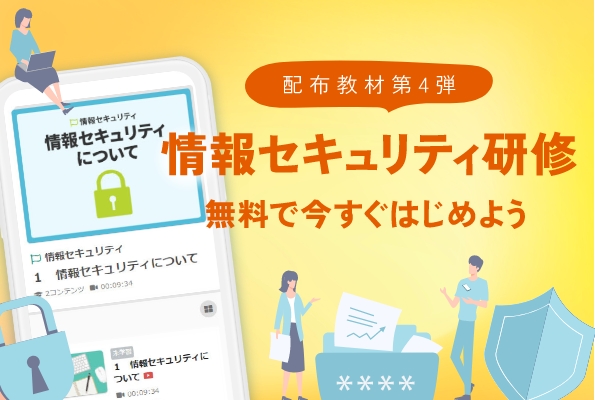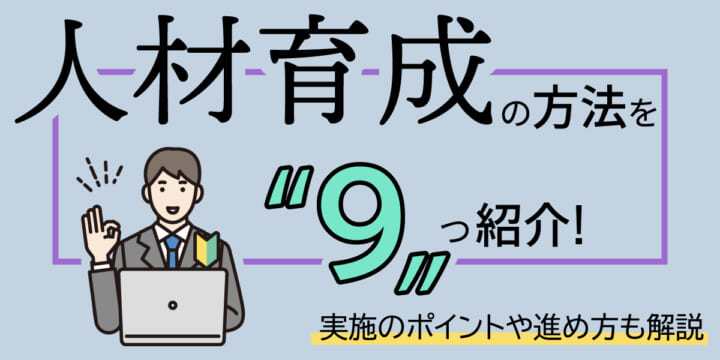5 Steps for Creating Effective Instructional Videos
5 Steps for Creating Effective Instructional Videos
Every year, more and more companies are creating manual videos to efficiently provide training and explanations to their employees. However, there are probably many people who want to create manual videos but have questions such as "I don't know how to make a manual video" or "What are the benefits of creating a manual video?
This article introduces the usage scenarios, advantages and disadvantages, creation procedures, and cautions for manual videos. Please refer to this article if you are considering the introduction of manual videos or are researching how to create them.
Content
- Situations where manual videos can be used
- Benefits of Creating Manual Videos
- Disadvantages of creating manual videos
- Basic steps to create a manual video
- Things to keep in mind when creating manual videos
- Improved comprehension with information-organized manual videos
Situations where manual videos can be used

Manual videos can be used in a wide range of situations, including explanations of work procedures and in-house training.Unlike paper media, video can show actual actions, making it suitable for employee training and job explanations.I am sure you will. Below are some specific situations where manual videos can be used.
Explanation of Business Procedures
There are many benefits to having a manual video of business procedures.
Conventional explanations of work procedures require an instructor to go to the site to show the actual work, which requires time for scheduling, travel to the site, and response to questions received at a later date. However, with manual videos of work procedures, it is possible to show actual operations on video, making it possible to provide explanations to some extent without going to the work site.
In particular, since explanations for new employees tend to be the same every time they join a company, manual videos are very useful because they can be created once and used over and over again. When giving supplementary explanations in person, it is possible to proceed on the assumption that the employee has seen the manual video, which greatly reduces the burden of instruction.
One of the advantages of creating a manual video for target employees when there is a change in work procedures is that it saves the time of explaining the change verbally to everyone. In addition, even if the person in charge is not available at the time of an emergency problem such as a machine breakdown, a manual video that allows the recovery procedure to be confirmed on video will allow the site to handle the situation to a certain extent alone.
Introduction of sales expertise
Manual videos can also be used to share sales know-how within the sales department, from customer visits to closing the deal.
Video explanations of the skills of employees who are achieving excellent results will help improve the abilities of those who are not growing as well as the entire sales department. Preparing videos for different lengths of service and sales levels will help improve skills from career-based education and lead to increased sales for the entire company.
Training for new recruits and employees
By preparing manual videos tailored to the target employees, they can be used for a variety of in-house training programs, such as training for new employees and skill development training.
The manual videos for new employee training can be used flexibly according to the target audience and purpose of use, for example, by comprehensively including basic content such as morals as a member of society, company rules, business manners, and business card exchange in the manual videos for new employees, and by explaining how to instruct younger employees for mid-career employees.
For example, a company that operates a chain of stores can efficiently conduct training for store managers by creating videos of store operation manuals.
The range of uses for manual videos in training is wide.
Product Instruction Manual
In some cases, depending on the product, it may be easier for customers to understand the instruction manual by making it into a video. For example, a video of an instruction manual for an assembled product will make it easier for the customer to visualize the detailed procedure and work more smoothly.
Another advantage is that with a paper instruction manual, it is easy to miss small notes, but with a video, they can be included as part of a sequence of events.
However, when making a video of an instruction manual, attention must be paid to the shooting environment and angles so that the work at hand can be clearly seen.
Benefits of Creating Manual Videos

There are four advantages to creating manual videos
(i) Reduction of training costs
(2) Reduce the burden on customer support staff
(iii) Can increase viewer understanding
(4) Viewing at any place and at any time
The more training sessions are reduced, the more cost savings can be realized, making the introduction of manual videos highly worthwhile. Manual videos that can be viewed on a smartphone or computer can be viewed at any location and at any time, and do not require you to stop working for long periods of time.
In addition, the videos can be archived for repeated viewing, which will improve the target audience's understanding by watching them over and over.
Advantage 1: Reduction of training costs
The production of training videos can reduce training costs and administrative tasks. Training costs include fees for lecturers, venue, printing of materials, and transportation costs for lecturers and employees to and from the venue.
In addition, training using manual videos will reduce the burden on training staff by eliminating the need to print and bind materials, coordinate schedules with instructors, and other tasks. Videos can be produced once and viewed repeatedly, making them cost-effective.
Advantage 2: Reduced burden on customer support staff
The use of video in instruction manuals will lead to a reduction in customer inquiries. This is because explanations that were difficult to understand in paper instruction manuals are easier to convey through video.
By reducing the number of customer inquiries, it reduces the time and effort required for the person in charge to explain the details of the inquiry. This will reduce the burden on employees in charge of customer support and will be effective in improving operational efficiency.
Advantage (3): Can increase viewer understanding.
Manual videos can be used to increase viewers' understanding of the manuals compared to paper-based media. This is because the use of video images can provide a more concrete image of something that would be difficult to explain in paper-based media.
This eliminates the need to visualize work procedures from textual information, thereby reducing misunderstandings and misconceptions while deepening understanding of what is being explained.
Advantage 4: Can be viewed at any location and at any time.
Another advantage of manual videos is that they can be viewed at any location and at any time. By producing manual videos in advance, there is no need to clear one's schedule or travel to a venue for training.
If the manual videos are uploaded to the company's cloud server, they can be viewed from a smartphone or computer during work breaks, so supervisors and senior employees will not have to stop working every time they are asked a question.
The advantage is that you can watch the video as many times as you like if you do not understand or if you have any concerns, which makes it easier to retain the content being explained.
Disadvantages of creating manual videos

While there are many advantages to creating manual videos, the following disadvantages also exist
(i) Costly when creating videos
(2) Cannot be easily modified once completed.
(iii) Not suitable for complex explanations.
(iv) Depends on the motivation of each viewer
The production of manual videos is costly, but in the long run, the reduced costs associated with training will provide a sufficient return.
However, it is important to shoot and edit the film carefully, keeping in mind that it cannot be easily corrected, as additional costs will be required for reshoots and re-editing.
In addition, since the motivation for viewing manual videos differs from person to person, efforts must be made to maintain motivation so that there is no variation in the level of understanding among viewers.
Disadvantages (1) Costly when creating videos
Manual videos are effective in reducing training costs, but the production of videos involves costs for planning, shooting, and editing.
Video production requires the use of filming equipment and editing software, so the initial cost of preparing the tools is necessary. In addition, it is difficult to engage in normal business activities while shooting and editing videos, which reduces human resources for a certain period of time.
When video production is outsourced, production costs of several tens of thousands to several hundred thousand yen per video must be paid.
Thus, the disadvantage of both in-house and outsourced video production is that it requires a certain cost.
Demerit 2) Cannot be easily modified once completed.
Another disadvantage is that it is difficult to respond quickly to manual videos because they must be edited again using editing software to correct them.
While paper media can be corrected by rewriting or adding text, video requires reshooting and re-editing using software. Re-shooting requires time and effort, as it requires securing personnel and setting up the location from the beginning.
Even if editing the video is all that is required, it is time-consuming if you are not familiar with editing software. If there is no one in-house who can use editing software, you will have to resort to outsourcing, which will require additional outsourcing costs.
Demerit 3) Not suitable for complex explanations.
Manual videos with complex explanations are not suitable for visualization because they tend to take a long time to view and are difficult to keep the viewer focused. The more complex the explanation, the more content to be included in the manual.
Even if detailed explanations are provided, there is a possibility that viewers will lose their concentration halfway through the video, give up on understanding, or not watch the video to the end.
One countermeasure is to create multiple short videos that focus on the items to be explained, but this also increases production costs.
Disadvantage 4: Depends on the motivation of each viewer.
Viewing of manual videos is often done by individuals, and serious viewing depends on the motivation of each individual. Because manual videos can be viewed at any time and any place, it is impossible for the administrator to know whether the subject person has watched the video properly.
It is also possible that videos may not be played or skipped in the first place because "they won't get caught anyway. Even if a system that allows managers to track viewing status is implemented, some people may not be motivated and simply skip over the videos.
If the system continues to rely on the motivation of each individual, there may be a gap in understanding and proficiency between viewers who are serious and those who are not. It is important to establish a management system, such as by conducting tests to check the content of videos to ensure uniform levels of understanding.
Basic steps to create a manual video

Creating a manual video involves the following five steps
(1) Prepare a draft of the contents and structure of the manual
(2) Gather materials and information
(iii) Script preparation
(4) Shooting of video and recording of narration
5) Edit the video
Video is not just about shooting.To create a video that properly communicates what you want to say, you need to be well prepared., will be one of the solutions for employees both at home and abroad.
First, clarify the purpose of creating the video and gather the necessary information. Next, a script is created based on the information gathered, and the video is generally created through the process of shooting and editing. Each step is explained in detail below.
Step 1: Prepare a draft of the content and structure of the manual.
First, consider the purpose of making a manual video, decide on the matters to be explained, and create a composition plan. In the composition drafting stage, it is important to clarify what you want to convey and what you want to communicate.
Considering who the video is aimed at and the level of knowledge and experience of the audience, it is easier to envision the content and explanations that should be included. At this point, it is important to identify the areas where most people tend to stumble and the issues that may need to be explained.
Once you have decided on the content, estimate how long the video will be and calculate the approximate viewing time. 5-10 minutes is a good guideline, but if it is too long, plan to break it up into multiple videos.
Step 2: Gather materials and information
Once the proposed structure is finalized, we will gather the materials and information needed to create the video. You will be able to gather this information efficiently by making a list in advance.
If you have a concrete image of what information is needed according to the proposed structure, it will be easier to make a list and less likely to be omitted.
If it is difficult to visualize what information is necessary even after looking at the composition plan, go back to step (1) again to flesh out the composition plan. If the image of the completed manual video is still vague, the amount of materials and information to be gathered may become too large, and it may take time to select and discard information, or you may end up with a video that does not capture the main points.
Step 3: Prepare a script
Be sure to create a script, as it will have a significant impact on the quality of your video. As you create the script, you will have a clearer image of the shoot, and you will be able to notice any missing content or material before the shoot.
If the lack is noticed after filming has begun, the time of those involved in the video production may be wasted. To avoid the time and expense of additional reshoots and re-editing if you notice omissions after filming, prepare the script as text or storyboards.
Ideally, the script should contain the lines of narration and information on materials and images to be inserted, so that the viewer can visualize the finished video by looking at the script. A script that clearly describes the lines and progression of the video will ensure that nothing is left out and that the filming will go smoothly.
It is important to have other members of the team read the completed script to check that it is objective and communicative.
Step 4: Shooting of video and recording of narration

When you are ready to shoot, you can actually shoot the video and record the narration. The schedules of the people involved in the filming should be coordinated in advance, and the date of the filming should be decided upon.
Once a shooting date has been set, it is important to give the script to the narrator role as soon as possible. Since the narrator is responsible for explaining and facilitating the video, he or she must be able to read the lines smoothly, as well as understand the content of the script.
Give them priority when the script is completed so that they can practice so that the audience can understand the content before the day of the shoot.
When shooting, make sure the background is free of extraneous objects and set the lighting in a position where shadows will not interfere with the shot. When shooting indoors, although indoor lighting is available, it is recommended to prepare lighting equipment and reflectors to make the reflection as good as possible.
When shooting, take pictures from as many angles as possible, so that you can select a cut that is easier to view later. In particular, when photographing the hand, it is recommended to take both a close-up of the hand and a close-up of the entire image.
Also, try to keep cuts short to avoid having to reshoot from the beginning due to problems during the shoot.
When recording audio, it is also necessary to take a test shot beforehand to see how much ambient noise will be present. In some cases, especially when shooting in a factory or outdoors, it may be necessary to take separate audio shots because loud noises may be included.
Step 5: Edit the video
After filming is complete, it is time to edit the video. The first step is to cut unnecessary scenes. Do not delete the cut material immediately, but keep it, as you may use it later.
Once you have extracted only the necessary portions, you can insert tickers and subtitles into the video. Once the video has been edited, we will check to see if it is a video that can be watched without getting bored until the end.
When editing a video, have someone other than the person in charge of editing watch the video several times during the editing process to prevent significant revisions from appearing after completion.
An objective view from more than one person makes it easier to find areas for improvement that could not be noticed by one person.
One thing to keep in mind when creating a manual video is to make it easy for the viewer to understand. To create videos that are easier to understand, it is important to prepare videos for each theme, focus on key points and emphasize them with tickers, and edit the videos in a way that helps viewers understand.
Things to keep in mind when creating manual videos

When creating a manual video, it is important to put the viewer first and make the content easy to understand., will be one of the solutions for employees both at home and abroad.
To make videos more easily communicated, information must be organized in an easy-to-understand manner, such as by preparing videos by theme or by focusing on key points and emphasizing them with tickers.
Focus on one theme per manual video.
To avoid confusing the viewer, be sure to address one topic per manual video.
If multiple topics are covered at once, the viewer may not fully understand the content of the video and the topics will switch from one to another, which may reduce the overall level of understanding of the matter being explained.
In addition, even if you want to check the parts of the video that you do not fully understand during a break in your work, you will have a hard time finding the part you want to see if the video is long enough to include multiple topics. If there are multiple topics you want to cover, create a shorter video for each topic so that viewers can easily understand what you are explaining and quickly find the topic they want to see.
Add tickers and animations
When editing a video, use tickers and animations at important points to convey to the viewer the points you want them to understand at a minimum.
The trick to inserting a message is to keep the text large and the number of characters small. The more the number of lines, the more words will be buried, and the less emphasis will be placed on the message.
Don't use all of the narrator's commentary as a ticker tape; instead, narrow down the dialogue. If you insert a lot of tickers, viewers will struggle to read the text and will not be able to concentrate on the video.
Another recommendation is to incorporate animation to direct the eye to areas in the video that need attention. By adding animation effects as needed, you can avoid missing some important but unnoticeable parts of the video.
Consider using with paper materials if necessary.
When explaining the overall picture of a job or work procedures that are difficult to convey in a video, it is best to use paper materials in combination.
In contrast to video, which can increase understanding visually through images, paper-based materials are a highly listable medium that allows multiple items to be spread out and viewed. It will be easier to get a concrete image if you show which part of the paper document corresponds to the part explained in the video.
Also, lists such as the "list of tools to be used" may make you want to stop the video and take notes. By preparing the list as a paper document, you will be able to concentrate on watching the video because you will not have to stop the video once and take notes.
Improved comprehension with information-organized manual videos
There are many benefits to creating manual videos, not least of which are reduced training costs and improved learning efficiency. The key to creating a manual video is to clarify what you want to convey and organize the information in a form that is easy to understand.
Separate videos for each theme or unit, or emphasize them with tickers, will enhance viewers' understanding. One disadvantage of manual videos is that it is difficult for the administrator to check the viewer's level of understanding.
LearningBOX, an easy-to-implement e-learning system, makes it easy to create questions on the topics explained in the manual videos, so you can use it to monitor the level of understanding of your target audience. The system can be used to create a variety of content, including manual videos.
If you want to conduct training efficiently using manual videos, you can start by using our free Free Plan to see how it works.

- Harassment educational materials are now available free of charge.
-
What is CBT and its difference from IBT?
Compare its advantages and disadvantages.
Comment ( 0 )
Trackbacks are closed.








No comments yet.